written by CIMA interns Olivia LaManna and Brigid Kennison
On December 5th, 2019, CIMA members were given a tour of the Frick’s temporary exhibition of Bertoldo di Giovanni: The Renaissance of sculpture in Medici Florence. The tour of this exhibition was introduced by Alexander Noelle, and given by Claudia Daniotti. Noelle is the 2017–19 Anne L. Poulet Curatorial Fellow at the Frick and is a doctoral candidate at the Courtauld Institute of Art. Daniotti is CIMA’s fellow and is an art historian and researcher specializing in Italian Renaissance art, with an emphasis on iconography, the classical tradition and the transmission of visual motifs from antiquity to the present.
The Frick, opened in 1935, is known for its distinguished Old Master paintings and outstanding examples of European sculpture and decorative arts as well as being internationally recognized as a premier museum and research center. The museum’s collection was assembled by the Pittsburgh industrialist Henry Clay Frick and is housed in his former residence on Fifth Avenue. One of New York City’s few remaining Gilded Age mansions, it provides a tranquil environment for visitors to experience masterpieces by artists such as Bellini, Rembrandt, Vermeer, Gainsborough, Goya, Whistler, works by Bertoldo di Giovanni, which is the exhibition that the CIMA members were given a tour of.
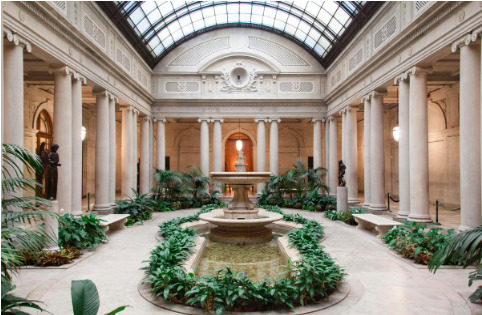
The Florentine sculptor Bertoldo di Giovanni is not a well documented artist—he is assumed to have been born around 1440 and to have died in 1491. He was a student of Donatello and a teacher of Michelangelo but not nearly as famous as either. Bertoldo was also a great favorite of Lorenzo “il Magnifico” de’ Medici, who was his principal patron. This show at the Frick, Bertoldo di Giovanni: The Renaissance of Sculpture in Medici Florence is the artist’s first-ever exhibition. The exhibition’s principal objective is to prove that Bertoldo is not just an empty vessel connecting Donatello to Michelangelo, as was asserted in Giorgio Vasari’s The Lives of the Most Excellent Painters, Sculptors, and Architects, but that he is an accomplished artist in his own right deserving of more recognition.
The exhibition consists of more than twenty sculptures, reliefs, medals, and statuettes—constituting nearly his entire extant oeuvre. The pieces are on view exclusively at the Frick, which also houses the only sculptural figure by Bertoldo outside of Europe: a single Shield Bearer, pictured below. Bertoldo was an expert in the making of bronzetti, small bronze statues like that of the Shield Bearer. These statuettes are meant to be held and turned over in your hand, studied carefully, they’re not meant to be admired at a distance like larger statues may be. Bertoldo’s bronzetti demonstrate the skill and care necessary to create a small piece in such detail.
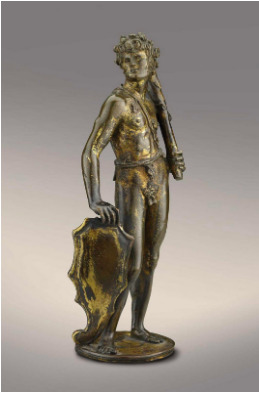
The Frick Collection
The first bronze relief we looked at is the Battle which shows a dynamic and powerful battle scene. Bertoldo’s largest bronze is an adaptation of an ancient sarcophagus that depicts a battle between Roman soldiers and barbarians. The sarcophagus was severely damaged long before Bertoldo would have seen it, but he reconstructed the scene of organized chaos by following what was left in the ancient example. But it is no mere copy, he had to recreate the missing figures and translate the forms into bronze and, in doing so, compressed and heightened the relief so much that the figures appear almost freestanding. Instead of repeating the narrative of Romans attacking foreigners, here all the soldiers attack one another without any obvious underlying logic or clear identification. Bertoldo created a scene with an unfixed narrative, thereby encouraging discussion among viewers attempting to discern its subject.
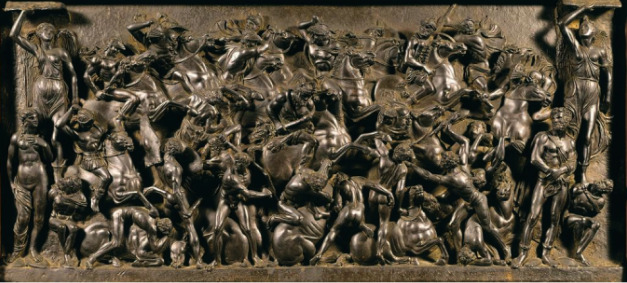
This piece was commissioned by Lorenzo il Magnifico and would have been hung on the mantelpiece in his home. Michelangelo spent a significant amount of time in that very dining room where it hung in Palazzo Medici and it is speculated that Battle inspired some of Michelangelo’s early bronze reliefs which depicted battle scenes such as this one.
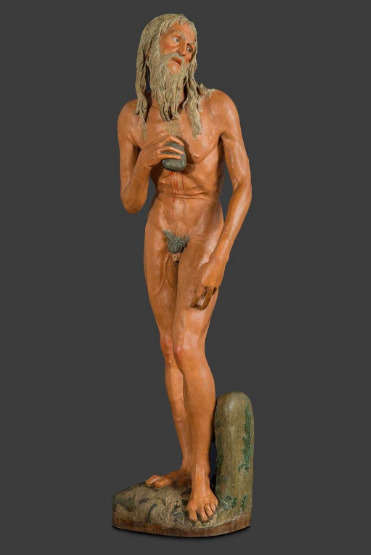
St. Jerome, ca. 1465–66. Wood, gesso, and paint.
Courtesy of the Frick Collection, New York.
This sculpture, titled St. Jerome is believed to be completed in 1465-1466 and was created out of wood and heavily molded and then painted gesso for the details, such as the blood, veins, and hair. This sculpture was probably intended for display in an elevated niche. Saint Jerome was a hermit and here the artist depicts him beating a rock on his chest while blood drips down his face showing sorrow and pain. By beating a rock on his chest Saint Jerome is doing a type of mediation or adoration for Jesus. Although the sculpture has been attributed to Donatello since the sixteenth century, scholars beginning in the late nineteenth century have expressed doubts about its authorship. While certain aspects of the sculpture’s form are similar to sculptures by Donatello, the pose and other details are similar to sculptures by Bertoldo, such as the Supplicant. Donatello—who had ties to the city of Faenza, where the sculpture has been since its creation—may have begun the sculpture toward the end of his life and left its completion up to Bertoldo.
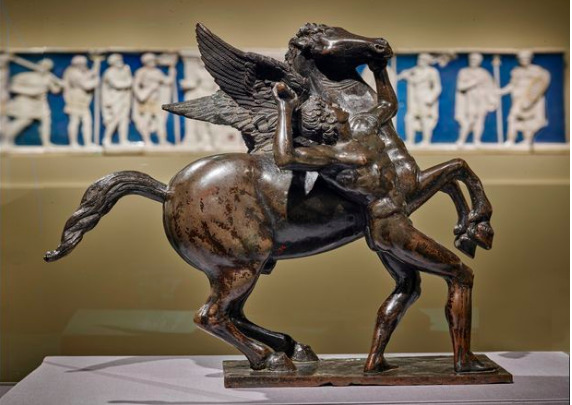
Bellerophon Taming Pegasus was created and designed by Bertoldo di Giovanni, but casted by Adriano Fiorentino. The sculpture depicts the struggle of the hero Bellerophon taming the winged horse Pegasus. This was a common subject of ancient texts and artworks, but Bertoldo’s depiction was the first since antiquity. Following a classical ode, the sculptor captured the moment at which Bellerophon bends Pegasus to his will using an enchanted bridle. While the bridle is slung over the hero’s left shoulder, the sculptor departed from the poem, in which Bellerophon subdues Pegasus by gently placing the charmed reins on the horse, instead transforming the episode into a violent contest between man and beast. Bertoldo created the wax original, then entrusted the bronze casting to his collaborator, Adriano Fiorentino. This idea of Bertoldo creating the sculpture and having another artist cast it in bronze was a common practice of his. Bellerophon Taming Pegasus is considered to be Bertoldo’s masterpiece and is the only statuette signed by Bertoldo. The signature is only visible on the bottom of the base, where it says “Bertoldo modeled me; Adriano casted me.”
This exhibition is the first-ever to exist on the Florentine sculptor Bertoldo di Giovanni (ca. 1440–1491), a Renaissance artist who breathed new life into antiquity. If you were unable to join us on the members-only tour, we hope you get the chance to visit it on your own before it ends on the 12th of January, 2020.
